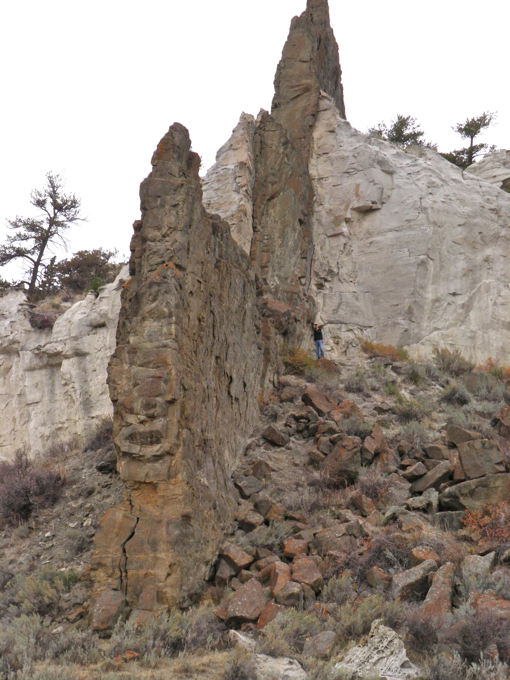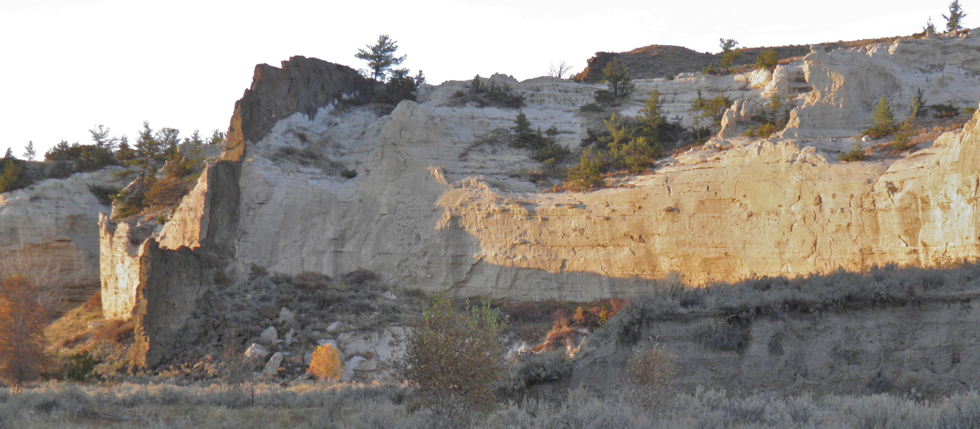 Igneous Dike Cuts Through Eagle Sandstone Igneous Dike Cuts Through Eagle SandstoneWhat's in a name? . .
This photo was taken near the place where Eagle Creek flows into the Missouri River 40 miles northeast of Ft. Benton. Eagle Creek is a fairly small stream that starts in the Bears Paw Mountains south of Havre, but it was here that the Eagle sandstone (a.k.a. Eagle Formation), one of Montana's most prominent sandstone formations was identified and named. Geologists often name a rock layer after the location where it is first identified - in this case, Eagle Creek. This stretch of the Missouri River is called "The White Cliffs of the Missouri" because the Eagle sandstone forms such scenic cliffs along here. It can be seen in other parts of the state as well . . . The "Rimrocks", which form the cliffs overlooking Billings, are one of its most recognizable exposures of Eagle sandstone. (photos by Jim Schulz)
Pardon the interruption . . .
The other interesting formation in this photograph is the dark igneous rock that cuts through the Eagle sandstone. This feature was formed when magma forced the sandstone to crack, and then filled the crack where it cooled to become rock. Such outcroppings, which are common in the White Cliffs area, are referred to as "intrusive igneous formations" (or intrusions) because they formed beneath the surface (intrusive = "inside", or below the surface). The one shown in the photo is called a "dike". If the magma had squeezed between the layers, it would be called a"sill". Dikes cut across layers, whereas sills form between layers. As erosion removes less durable overlying sedimentary rock, these and other intrusive formations are exposed.
Which came first? . .
In order for the crack to form and the magma to force its way in, the sandstone had to be there first. Known as the "Principle of Cross-Cutting Relationships", this is one of the basic principles in geology. Unlike sedimentary rock (sandstone, shale, etc.), radiometric dating can be used to determine the age of igneous rocks. The dike and other intrusive formations in this area formed about 55 million years ago, during a time when there was volcanic activity in central Montana. Once the age is determined, geologists can narrow down the age of sedimentary rock layers that are "cut across" by dikes and other intrusions. Geologists believe the layers Eagle sandstone are made of sand deposited during the late Cretaceous Period (70 to 80 million years ago) along the coast of a shallow sea.
Interested in learning more about this area? . . .
Take a look at a book titled, "Magnificent Journey: A Geologic River Trip with Lewis and Clark through the Upper Missouri River Breaks National Monument" by Otto Schumacher and Lee Woodward.
Below: Here is photo of the same dike with a cut bank of Eagle Creek in the shadows on the right. For a closer view of the dike, CLICK HERE. To see the same dike from another vantage point, CLICK HERE. To see a photo of a different dike a few miles from here, CLICK HERE.
 Term: plutonic formation (in your own words!)
|








